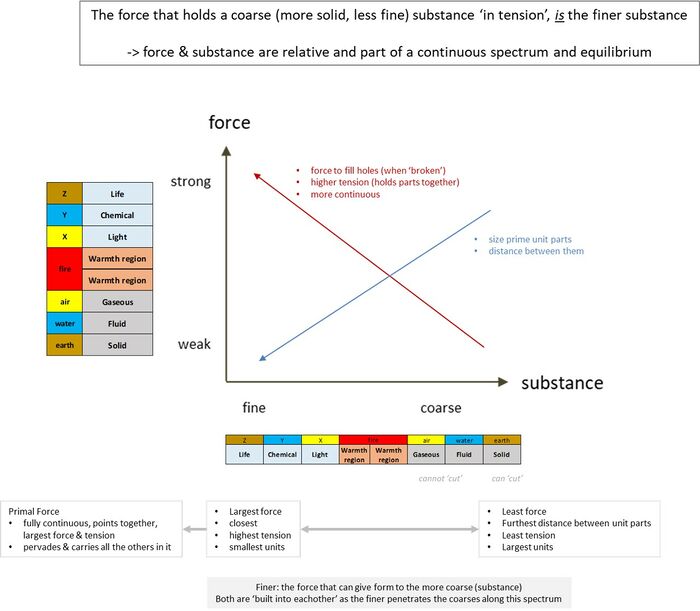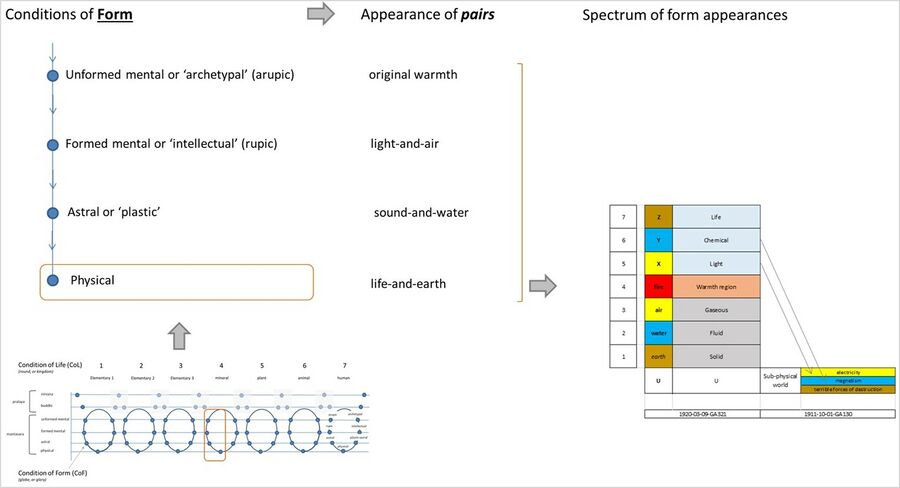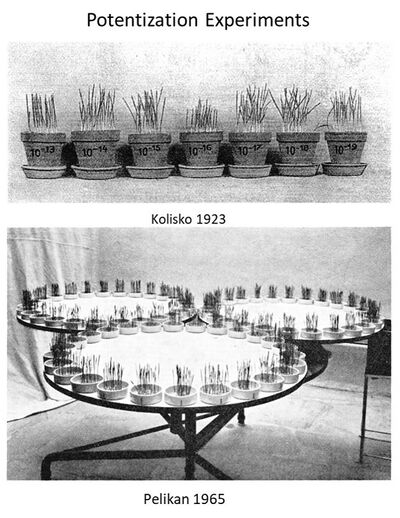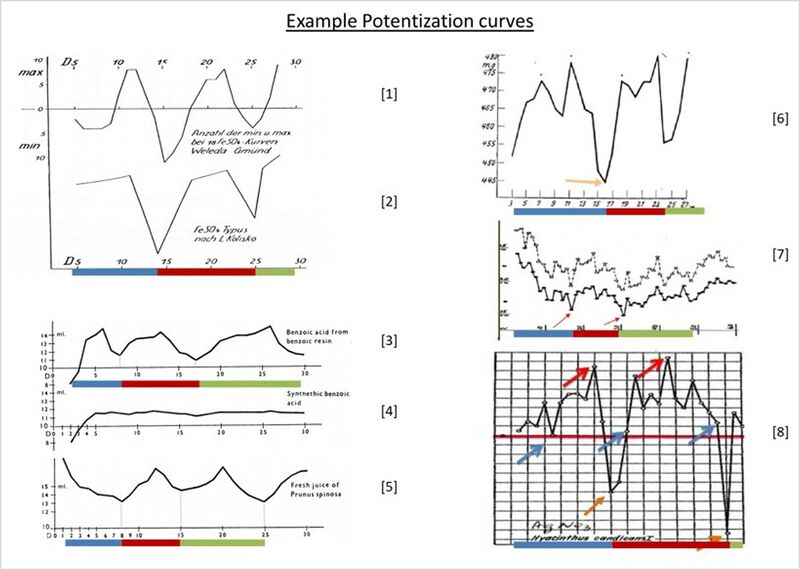Potentization
Potentization is a process to awaken non-material spiritual influences (called etheric formative forces) in matter, through controlled consecutive steps of dilution and dynamization. The mineral substance on Earth today has passed through various stages in which an original spiritual seed got form and various layers of clothing as it solidified down to physical matter (the element earth on Schema FMC00.006). With potentization, matter gets processed back into those earlier, higher states. Here the forces at work are not centric gravitational but peripheral etheric formative forces.
Potentization is the underlying principle on which Homeopathy is based, a medical treatment aimed at the Human etheric body and not directly the physical body, hence the laws of the etheric formative forces need to be considered.
Aspects
Background on potency vs dilution
A substance like salt can be diluted in water until it fully dissolves. With even greater solution, the dissolved substance keeps on expanding like a gas upto the point it can no longer be detected by taste or chemical reaction, not even with advanced methods such as spectral analysis. At a certain point, say a dilution of 1: 10^17 (1 mg of salt in 10 million liters of water) a point is reached where it can be argued there is not a single molecule left in the solution. Nevertheless homeopathy has shown the therapeutic effects on such highly diluted substances for over two centuries (say 1796-1810 to today). However such homeopathic preparations are not just dilutions, they through a process of rhythmic dynamization which is key to their functioning.
A potency is prepared by diluting a gram of a substance in 9 grammes of water, making 10 grammes of 10% solution. That solution is rhythmically shaken for a few minutes, whereby length and shaking rhythm are important. This is now the first potency. The same process is now followed by diluting the above first potency and processing it to get the second potency. And so on. A third potency would be denoted by D3, a dilution of 10^-3. Such potency however is not just a diluted solution, as shown experimentally by experiments since 1923 (see below).
Principle
Potentization is the awakening of the etheric formative forces in earthly substances through a process of dilution and dynamization.
Earthly substances have formed through an evolutionary process whereby spiritual seeds took on a form and astral and physical clothing through formative forces as they descended from higher planes down to the physical plane. Physical matter is a crystallization of a spiritual idea-substance via a macrocosmic process of densification.
When we take some physical substance, we take the mineral element. It is the fixed, rigid form of that substance, as a result of a cosmic process of formation. However the essence of any element can exist in seven forms (see the spectrum of the kingdoms and ethers). We distinguish the ponderable (material, governed by centric forces) and imponderable (etheric, governed by universal or peripheral forces). The point is that as the substance gets led back from solid to fluid to gaseous to warmth it goes into another domain, the etheric, where different types of forces are working.
Process
Potentization is a process to bring a substance back to these other and earlier stages of form appearance. As substance is a bearer of etheric forces of which the origin is peripheral (ai formative forces), the effect will be enhanced not by concentration but by expansion, for it is the rhythmic sequence of dilutions and successions or trituration which renders the potency effective.
In the potentized substances, a new force is at work which is aroused by rhythm. With increasing dilution substance disappears first physically then chemically and spectroscopically, while biological activity is increasingly enhanced through the invisible spiritual workings of the substance.
This is not an alone-standing fact that should surprise us, as earthly matter can appear and disappear in cosmic rhythms, as shown on the page on transmutation. And also in the yearly plant growth, we see a similar process of metamorphosis and a rhythmic oscillation between material condensation and etherization into an impondarable state of being.
The potentization process can be seen as an inspired emulation of the process we find in nature, as the substance is etherized by rhythmical dilution, and the physical form of the substance changed from solid to liquid to gas and passes over into more refined non-material conditions.
For further research on the particular rhythms in the etheric formative forces with other methods, see the page on formative forces.
Based on and further reading in references [2], [4] and [6] in the 'Further reading' section below.
Experiments and results
In 1923, Lily Kolisko accomplished the first set of experiments to show the effects of potencies on the growth process of plants. Many people replicated these (or did similar) experiments, and confirmed the findings. An overview is given in reference [1] below, which also includes a copy of the original study. Amongst other sources were Theodor Schwenk in 1954 [3] as well as Wilhelm Pelikan and Georg Unger in 1965 [5].
In fact so many publications can be found that most probably no complete and exhausive overview exists, see eg the experimental results shown by Rudolf Hauscha in 'The Nature of Substance'.
Note: the infamous and much debated experiments published by Jacques Benviste in Nature in 1988 are discussed in [1]. This is put in perspective on the page on worldview wars and Relationship between mineral and spiritual science.
Various aspects
- examples experiments potentization and plant growth in explanation polio (infantile paralysis) based on effects of soil (1923-10-31-GA351)
Illustrations
Schema FMC00.172 elaborates on the simpler FMC00.172A (see: Force substance representation). It shows how on physical Earth, coarse substance is 'Matter', and fine substance becomes 'Force', in the language of physics in mineral science. However between coarse substance (atoms) is the fine substance (ethers, force), and both form a balance that sustains itself, a bit like an extension of the phase diagram in chemistry.

Schema FMC00.006 is to be read starting lower left. The Earth has gone through a number of Conditions of Life (CoL), and we have arrived in the current fourth (CoL) and the fourth and lowest Condition of Form (CoF) through three earlier stages CoF (above left). Each Condition of Form saw the appearance of pairs of elements and ethers. In the current physical Condition of Form we can therefore find a substance along a spectrum of seven 'form appearances'. See more on Three dimensions of evolution.
Note the physical substances considered here are part of the physical Condition of Form, as put in perspective by Schema FMC00.006A on Spectrum of elements and ethers.
Compare with Schema FMC00.556 on Tetractys.

Schema FMC00.152 shows experimental setups for scientific research into potentization.
The experimental method consists in planting grains in a series of (eg 30 or 50) pots, watering the pots with one of a continuous series of potencies of a given substance, letting the grains germinate and grow, and measuring the seedlings in terms of leaf and root. The average heights reached with each potency are then calculated and plotted to deliver the potency curves for a given substance.

Schema FMC00.012 shows several examples of potentization curves taken from different sources

Lecture coverage and references
1923-08-30-GA227
I have had to take you in thought away from the earthly world into that of the stars and their inhabitants, so that, in a way suited to the present time, your attention may be directed away from the world in which human beings are generally engrossed, to a world they have to enter through deeper knowledge, if they wish to experience their future aright. Today, people in general are little inclined to detach themselves from the claims of the material world and to seek the spiritual directly in the physical world around them. We have no time now to dwell on the obstacles met with when, in psycho-analysis, for example—to which I shall be referring tomorrow—attempts are made to investigate at least the spiritual part of Man.
It is, however, precisely from observing directly the sense-perceptible that a right path will open out for those who wish now to work entirely within the field of present-day science, if they really seek to discover the spiritual there. It can be done.
Definite proof of this is to be found in the booklet just issued by our Institute of Physiology and Biology at Stuttgart. Here Frau Dr. Kolisko has published the results of a beautiful piece of research under the title Physiological and Physical Proof of the Efficacy of the smallest Entities. You know how homeopathy likes to work with highly diluted substances. By this means, by bringing physical substance in a highly diluted form, a way is opened into the spiritual. Frau Dr. Kolisko has now succeeded in showing, by an exact method, that the smallest entities, the highest dilutions, are effective. She has been working most conscientiously for a long time on the lines I have indicated, and she has now succeeded in producing dilutions in the proportion 1:1 trillion.
If any substance is completely dissolved in a glass of water, half of which is then thrown out and the remaining half poured into a full glass of water, we get a dilution of 1:2. When half the water is again thrown out and the remainder poured into a full glass, we get 1:4, and so on. Now in our Biological Institute at Stuttgart, by means of exact scientific methods, a way has been found to produce precise solutions of 1:1 trillion—thus arriving at the so-called higher potencies. The results can be seen in the case, let us say, of antimony, about which I spoke in the medical lecture given during our days here. We find that plant growth, for example, the growth of a grain of wheat, is reduced to its slowest rate at about the twenty-first potency, and brought to its fastest rate at about the twenty-ninth or thirtieth potency. So, you see, a substance has been diluted in fluid to a high potency, and we find that the lower potencies have a different effect upon plant growth while the highest potencies accelerate growth, which means that they give the greatest stimulus to the life-force. In this way it has been found possible to break down the purely material, so that the spiritual can manifest there. For if you split up material substance, not into atoms as atomists would have it, but in such a way as to bring but the activity of its functions and forces, then you are showing willingness, I would say, to go over to the spiritual by permeating matter itself with spirit.
You can imagine now what this means for observing accurately how remedies work on the human organism, for the effect can indeed be seen. The dilution is prepared; you have it in a laboratory flask, and you drop into this potency a grain of wheat; then into the potency in the next flask you drop another grain, and so on—grains and grains of wheat. For in the course of this exact research whole rooms were filled with these germinating grains, showing the effect of each potency on the soil out of which the grains sprout. That is what must be done in science to-day, in order to drive material knowledge on into the realm of the spirit. You know what contention there has been between homoeopaths and allopaths concerning the effectiveness of the smallest entities in the higher potencies. The whole affair up to now has been a question of opinion—the allopaths holding to one view, the homoeopaths to another. Here, however, it is not a case of siding with homoeopaths, but of establishing scientifically the actual facts. In the future it will naturally be known when remedies should be applied in the direct allopathic way, and when in a dilution of the correct potency, so that they may have the desired effect on the patient—particularly on his etheric body, which represents the life-forces. We shall know exactly where to draw the line—here you must give an allopathic treatment, there a homoeopathic one. For just as other scientific experiments are carried out with the utmost exactitude, so in this case Frau Dr. Kolisko has shown in her booklet, with the same exactitude, how the smallest entities really work. What was formerly mere surmise has been raised to the level of an important scientific subject.
But all this points to something further. Just look in this booklet at the accurately worked-out curves which show how the forces of growth go up and down; notice how the curves have to be drawn according to whether the potency is strong or weak, how with certain dilutions there is a minimum of growth, and in more dilute solutions—higher potencies—a maximum; then a return to the minimum, back again to the maximum—and so on. Thus, in the remarkably conscientious tracing of the curves, one gains direct insight into a rhythm working in everything material—a rhythm that is indeed the expression of the spiritual.
With human beings, we can turn from the metabolic system to the rhythmical system; it is possible in nature, also, to find in a quite exact, scientific way its rhythmical system. That is precisely what is to be seen in this work, which I believe may prove to be an important landmark, not only in the controversy between homoeopathy and allopathy but in all questions concerning our insight into nature. If the results of this research are estimated rightly, the laws of nature in future will no longer be sought only in the present atomistic way, by measuring and weighing; it will be recognised how in all material things there is a rhythm, and how in the rhythm of events in nature the rhythm of the cosmos is expressed.
1923-10-31-GA351
Since we in our Biological Institute in Stuttgart succeeded in proving the effects of the minutest quantities of substance, one must speak about these things, even in public, in a quite different way than formerly.
We have in Stuttgart simply shown that when one has any substance, dissolves it, dilutes it greatly, one has a tiny amount in a glass of water. One obtains, say, a 1 per cent solution. A drop of this is taken, diluted to a hundredth of its strength. It is now one ten-thousandth of its original strength. Again diluting this to one-hundredth of its strength, we have a solution one-millionth of the original strength. In Stuttgart we have succeeded in obtaining dilutions of one in a million, one in a billion—that is, with twelve zeros.
You can imagine that there is now no more than a trace of the original substance left, and that it is a question, not of how much of the original substance is left, but of how the solution works: for it works quite differently from the original.
...
We then took a kind of flower pot, and poured into it in succession the various dilutions. First, ordinary water, then the 1 per cent dilution, then the .1 per cent, the .01 per cent and so on, up to one part in a trillion. Then we put a wheat seed in. This grows, and it grows better in the diluted liquid than in the non-diluted! And the higher the dilution the quicker the growth: one, two, three four, five dilutions—up to twelve. At the twelfth, the growth becomes slower again, then increases again, then decreases again. In this way one finds the effects of minute quantities of substances. It is very remarkable. The effect is rhythmic! If one dilutes, one comes to a certain dilution where the growth is greatest, then it gets less, then again greater—rhythmically.
One sees, when the plant grows out of the ground, something works on it together with its substances, something which works rhythmically in its surroundings. The soil environment works into it. That is clearly to be seen.
...
Now other investigations have been made in Stuttgart. These things are extraordinarily instructive. For instance, one can do the following, instead of merely investigating growth—which is very important, especially when one is dealing with the higher potencies, say of one in a trillion—one can do the following.
We take metals or metallic compounds highly diluted in the manner previously described, for example, a copper compound solution, and put it into a flowerpot with some earth in it: we put it in as a kind of manure. In another similar flowerpot we put only earth, the same earth without the manure. Now we take two plants, as similar as possible, put one in the pot with the copper manured earth, and the other in the pot without the copper manure.
And the remarkable thing is: if the copper is highly diluted, the leaves develop wrinkles on the edges—the others get no wrinkles, if they are smooth and had previously none. One must take the same earth, because many specimens previously contain copper. One dilutes it with copper; the same kind of plants must be taken so that comparisons can be made.
Now we take a third plant, put it into a third pot with earth, but instead of copper, we add lead. The leaves do not wrinkle but they become hard at the top and wither when lead is added. You have now a remarkable sight. These experiments were made in Stuttgart, and you plainly see, when you look at the pots in turn, how the substances of the earth work on plants.
You will no longer be surprised when you see plants with wrinkled leaves somewhere. If you dig in the earth there, you will find traces of copper. Or if you have leaves which are dry and withered at the edge, and dig in the earth, you will find traces of lead. Look at a common plant, say mare's tail, with which people clean pots; it grows just where the ground contains silicon; hence the little thorns.
In this way you can understand the form of plants from the nature of the ground.
Potentization curves and their explanation
1920-03-31-GA312
As Rudolf Steiner explains in 1920-03-31-GA312, and in fact this lecture was the trigger for the consecutive experiments that confirmed this statement:
Increase potency and you will reach a zero point; beyond that point opposite effects appear. But this is not all; the further path on the negative side leads to another zero point for these opposite effects. Passing the second zero, you will come to a higher form of efficiency tending in the same direction as the first sequence, but of quite a different nature.
In the above example curves therefore, the regions delineated by the minima have been highlighted with coloured zones.
1961-11-06 - Lili Kolisko
Lili Kolisko refers to conversations with Rudolf Steiner (letter to Hans Kruger 1961-11-06) whereby he made the analogy of the different areas along the potentization axis with the effect of the metabolism, rhythmic subsystem, and nerve-sense system, saying:
- with potencies upto the first minimum one affects the metabolic subsystem, and between the first and the second minimum the nerve-sense subsystem
- using potences beyond second minimum does not have sense, as Man does not have further subsystems beyond the nerve-sense subsystem
- only the first potency should be shown with an exact value (comparing this with gender ripeness around age 14), beyond this point 'the effects flow into one another'
See also Note 1 in the Discussion area below
Discussion
Note 1 - Potentization curves and Man as a threefold being
Kolisko makes the analogy with the workings of the hierarchies in Man - probably remembering 1924-05-18-GA236, and how one can imagine overlapping bell-curves with the effect of the third hierarchy on Man upto age 21, followed by the second hierarchy working between ages 21 and 42, and the first hierarchy between ages 42 and 63, however with the second hierarchy already starting at age 14 and overlapping, similarly the third already starting at age 35 and overlapping.
From this she puts forth the idea that there are three areas where the impact of potency is predominantly one of the three subsystems (one can imagine three overlapping bell-curves - for the three subsystems - on the potency curve).
Contemplating that upto 14 years Man develops the etheric bodily principle, and then age of puberty is when the workings of the astral body starts, we are indeed reminded of 1924-07-21-GA319:
everything that constitutes the etheric body is intimately bound up with the metabolic and limb system everything that constitutes the astral body is bound up with the rhythmic system
See also: Man as a threefold being and Threefold working in Man
PS: Furthermore, one can find in anthroposophical communities the recurring statement that:
- D1-D10 – Metabolic-and-Limb System
- D10-D20 – Rhythmic System
- D20-D30 – Nerve-and-Senses System
No source for this has been identified as yet.
Related pages
References and further reading
- [1] - Lili Kolisko: 'Physiologischer und physikalisher Nachweis der Wirksamkeit kleinster Entitäten' (1923 -> 1997)
- also included in 'Agriculture of Tomorrow' (1939)
- [2] - Rudolf Hauschka: 'The nature of substance' (1966, German original in 1950) - Chapter 17
- [3] - Theodor Schwenk : 'The Basis of Potentization Research' (1988), the original 'Grundlagen der Potenzforschung' (1954 and 1972)
- [4] - George Adams: 'Potentization and the peripheral forces of nature' (lecture, 1961) - PDF download here
- [5] - Wilhelm Pelikan, Georg Unger: 'Die Wirkung potenzierter Substanzen : Pflanzenwachstums-Versuche mit statistischer Auswertung' (1965)
- [6] - Iwer Thor Lorenzen: 'Evolution through Incarnation and metamorphosis' (1969), Part III - About the Evolution of Earth and the Plant World.
- Note: Lorenzen’s books were translated by the FMC project and are awaiting publishing.
- [7] - Willem F. Daems: 'Was sind potenzierte Heilmittel?' (1993 revised version of original in 1972)
- 'Potenzierte Heilmittel : Ursprung, Wesen und Wirkungsnachweis von dynamisierten Substanzen' (1972)
- Viktor Itschner editor; contr: Willem F. Daems, Ernst Marti, Wilhelm Pelikan, Georg Unger, Alla Selawry, Horibert Kaufmann
